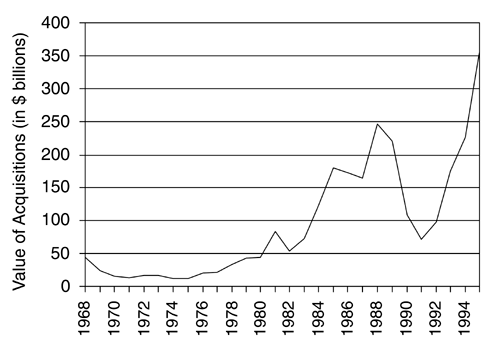More Attention on Directors
| Even before the recent corporate meltdowns and scandals, the general public was starting to pay more and more attention to directors and their activities. Prior to the mid-1980s, the public paid little heed to directors. For the most part, they were merely ornamental features of corporations. So, what changed? Why were people starting to scrutinize directors even before these scandals proliferated our nation's headlines? There are actually several reasons. First, the demand for better corporate governance occurred partly as a response to the tidal wave of mergers and acquisitions (M&A) activities of the 1980s. Figure 6-1 shows the deal value (in billions of dollars) of all acquisitions that took place in the United States from 1968 to 1995. [7] Figure 6-1. Yearly value of mergers and acquisitions. As we can easily see from the figure, M&A activity really picked up during the 1980s. But why? There are several reasons for this, including a more favorable tax environment, the gaining popularity and availability of junk bonds to finance acquisitions, increasing foreign competition, and the deregulations that were occurring in some industries. A recession and the collapse of the junk bond market lead to a temporary decline in M&A activity during the late 1980s, but one can see that M&A activity has been strong since then. There are a variety of reasons that companies acquire one another, but the most commonly stated reason is to generate more profits through synergies, be it operational or financial. For example, because HP and Compaq both make computers, they may be able to do a better job as a combined company rather than as two separate firms. In other words, two plus two equals five. A combination could help both firms. In fact, it was this very logic that HP CEO Carly Fiorina used to argue for the HP acquisition of Compaq ”cost savings, and the sharing of customers and technology. Why would an increase in M&A activity lead to more scrutiny of the boards? First, when a firm acquires another firm, the company making the purchase usually has to pay significantly more than the going market price for the company being purchased. This is great for the target firm's shareholders, but it's not so great for the acquiring firm's shareholders. This being the case, the shareholders of both the potential acquirers and targets will wish to keep a close eye on their respective boards. These boards must approve the acquisition before it goes to a shareholder vote. For the acquirer, the shareholders may not wish to pay too much for a target, or they may not wish to acquire the target at all. For the target firm, the shareholders may want to make sure that management does not adopt anti-takeover amendments , such as poison pills (a move by a takeover target to make its stock less attractive to an acquirer), that would make it difficult for the firm to be acquired for a nice price. Thus, the takeover wave that occurred in the 1980s brought more attention to boards . Other reasons why the board of directors started to get more scrutiny from shareholders have to do with two rules adopted by the SEC in 1992. First, the SEC required much more disclosure from corporations with regard to executive compensation, which included the reporting of granted stock option values. When the values of these compensation contracts were disclosed, there was some shock . As we discussed in Chapter 3, CEOs were receiving millions of dollars per year in salary, bonuses, and stock options. In many cases, the lavish compensations were being granted even if their firms were not doing that well. As such, shareholders began applying pressure on directors to exercise more oversight to make sure that the executives deserved what they were making. Second, the SEC made it easier for shareholders to communicate with one another. It was primarily the institutional investors, such as the pension funds CalPERS and TIAA-CREF, who took advantage of this rule. As a result, they were now able to create stronger shareholder coalitions that made it easier to put pressure on boards to challenge management. We will discuss institutional shareholder activism in more detail in Chapter 11. Given the new environment created by the SEC rules, it may not be surprising that some well-known CEOs, such as John Akers of IBM, Kay Whitmore of Eastman Kodak, Paul Lego of Westinghouse Electric, and John Scully of Apple Computers, all lost their jobs only one year later in 1993. All in all, with the increased takeover market and the new regulatory environment, shareholders and the general public put more pressure on directors to do their jobs. However, because these changes occurred or took shape only recently, the avid attention being paid to boards is a recent phenomenon . For example, it was only in 1996 that BusinessWeek started rating corporate boards. Are the boards ready for their next challenge in the wake of the shareholder confidence crisis? |
EAN: 2147483647
Pages: 118
- Using SQL Data Definition Language (DDL) to Create Data Tables and Other Database Objects
- Working with Queries, Expressions, and Aggregate Functions
- Creating Indexes for Fast Data Retrieval
- Writing External Applications to Query and Manipulate Database Data
- Working with Ms-sql Server Information Schema View
